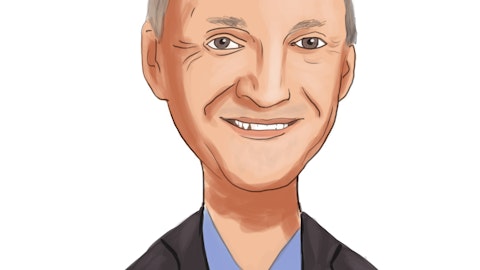F.N.B. Corporation (NYSE:FNB) Q3 2023 Earnings Call Transcript October 19, 2023
Operator: Good morning, and welcome to the F.N.B. Corporation Third Quarter 2023 Earnings Call. All participants will be in listen-only mode. [Operator Instructions] After today’s presentation, there will be an opportunity to ask questions. Please note this event is being recorded. I’d now like to turn the conference over to Lisa Hajdu. Please go ahead.
Lisa Hajdu: Thank you. Good morning, and welcome to our earnings call. This conference call of F.N.B. Corporation and the reported files with the Securities and Exchange Commission often contain forward-looking statements and non-GAAP financial measures. Non-GAAP financial measures should be viewed in addition to and not as an alternative for our reported results prepared in accordance with GAAP. Reconciliations of GAAP to non-GAAP financial measures to the most directly compatible GAAP financial measures are included in our presentation material and in our earnings release. Please refer to these non-GAAP and forward-looking disclosures contained in our related materials, reports and registration statements filed with the Securities and Exchange Commission and available on our corporate website.

A successful business person confidently managing their finances on a mobile device. Editorial photo for a financial news article. 8k. –ar 16:9
A replay of this call will be available until Thursday, October 26, and the webcast link will be posted to the About Us Investor Relations section of our corporate website. I will now turn the call over to Vince Delie, Chairman, President and CEO.
Vincent Delie: Thank you, and welcome to our third quarter earnings call. Joining me today are Vince Calabrese, our Chief Financial Officer; and Gary Guerrieri, our Chief Credit Officer. F.N.B. reported third quarter net income available to common shareholders of $143 million or $0.40 per diluted common share. This quarter’s performance represents EPS growth of 3% linked-quarter. Our results reflect the execution of F.N.B.’s long-term strategies, geared towards risk management, client primacy, generating organic growth, and diversifying fee-based income. Our third quarter efficiency ratio equaled 51.7% and is expected to remain in the upper quartile on a pure relative basis. In addition, operating leverage on a year-to-date basis is 8%.
Tangible book value per share has increased 12.5% year-over-year to $9.02 despite the impact of higher interest rates, and return on tangible common equity was again at a solid level of 18.2%. As we have previously mentioned, F.N.B. is well positioned to steadily increase market share in this volatile environment, given the strength of our capital and liquidity position in adherence to our consistent and conservative underwriting guidelines. Total deposits ended the third quarter at $34.6 billion, a 2.3% increase from the second quarter while maintaining a relatively stable mix of non-interest-bearing deposits of 31%. Our third quarter linked deposit growth once again outpaced the Federal Reserve H.8 deposit data, continuing a trend with quarterly outperformance versus the industry and demonstrating the strength of our granular deposit base and diversified geographic footprint, as well as our goal to be the primary bank for our clients.
In fact, FDIC deposit market share data released in September revealed that F.N.B. ranks in the top five in nearly 50% of the MSAs we operate in, and in the top three in nearly 30%. Despite the acceleration of deposit competition throughout the banking industry, F.N.B. spot deposits have decreased less than a 0.5% since year end 2022, demonstrating our trusted position as our customers’ primary operating bank. Our deposit growth this quarter was effectively funded dollar for dollar by our 2.5% linked-quarter growth in loans, which also meaningfully outperformed H.8 data. Commercial loan growth of 2.4% benefited from the highest level of quarterly production year-to-date, which was spread across the entire footprint. Since year end 2022, we have achieved 6.3% spot loan growth while building our CET1 ratio to 10.2%.
Tangible common equity to tangible asset ratio also continues to build, totaling 7.54% this quarter, even against the backdrop of higher rates. Additionally, our solid liquidity position and better than peer funding cost provides balance sheet optionality and the ability to support our clients’ capital needs. The loan-to-deposit ratio remains at a comfortable level of 92.9%. We also continue to invest in capabilities to gain market share and further outpace our competitors, particularly in the digital offerings we deliver for retail and business customers. Our award-winning eStore offers a unique platform, driving a better customer experience and product penetration. Our most recent implementation, the eStore Common application, creates a single universal account application for the majority of our consumer loan products and services, enabling customers to apply for multiple products simultaneously in a very streamlined manner.
In a few months, we will add our consumer deposit products to the Common application, which will facilitate faster customer onboarding across multiple products, and should meaningfully accelerate the adoption of the Common application. We will capitalize on our competitive advantage with our superior digital offering and the strength of our balance sheet to acquire and grow customer relationships across our seven state footprint. During the quarter, we fully charged off the commercial and industrial loan we mentioned in our second quarter earnings call. Gary will provide more information during his presentation. Absent that isolated charge-off, total net charge-offs would have been a modest 7 basis points, and total delinquency stood at 63 basis points.
Our growth strategies are balanced by a diligent focus on risk management. We closely monitor macroeconomic and market-specific trends to manage risk as part of our core credit philosophy, which has served us well in softer economic times. We remain steadfast in our approach to consistent underwriting and managing credit risk to maintain a balanced, well positioned portfolio throughout economic cycles, enabling us to serve our customers through business cycles in ways our competitors cannot. I will now turn the call over to Gary to provide additional information on our credit performance.
Gary Guerrieri: Thank you, Vince, and good morning, everyone. We ended the quarter and year-to-date period with our asset quality metrics remaining at good levels. Total delinquency decreased 12 basis points in the quarter to end at 63 bps and NPLs and OREO decreased 10 basis points to end at the solid 36 bps. Criticized loans were down 18 basis points with net charge-offs for the quarter and year-to-date of 47 basis points and 26 basis points, respectively. Excluding the isolated credit that Vince noted, net charge-offs for the quarter and year-to-date period were 7 basis points and 12 basis points, respectively. I’ll conclude my remarks with an update on our credit risk management strategies and CRE portfolio. As previously disclosed in the second quarter earnings call, we pledged a single $31.9 million C&I loan on non-accrual.
Based on alleged fraud and upon later findings uncovered during our ongoing investigation, including subsequent bankruptcy filings by our borrower and its primary supplier, the outstanding balance was charged off. We will continue to monitor the bankruptcy process closely and aggressively pursue all opportunities to recover a portion of the charge-off. Total provision expense for the quarter stood at $25.6 million providing for loan growth and the previously mentioned charge-off in excess of the $13 million specific reserve that we allocated to it at the prior quarter end. Our ending funded reserve decreased $12.1 million in the quarter and stands at $401 million or a solid 1.25% of loans reflecting our strong position relative to our peers.
When including acquired unamortized loan discounts, our reserve stands at 1.39% and our NPL coverage position remains strong at 3.94%, inclusive of the unamortized loan discounts. We remain committed to consistent underwriting and credit risk management to maintain a balanced well-positioned portfolio throughout economic cycles and continue to perform full stress tests of the loan portfolio on a quarterly basis. We were pleased with the outcome of the result of the recent exercise, which confirms that our diversified loan portfolio enables us to withstand various economic downturn scenarios. Regarding the non-owner-occupied CRE portfolio, delinquency and NPLs remain very low at 31 basis points and 20 basis points, respectively, confirming that our consistent underwriting and strong sponsorship demonstrates the ability to perform in a rising rate environment.
In closing, asset quality metrics ended the quarter at good levels, and we continue to generate diversified loan growth in attractive markets. We closely monitor macroeconomic trends and the individual markets in our footprint, and we’ll continue to manage risk aggressively. As part of our core credit philosophy, which has served us well throughout various economic cycles. I will now turn the call over to Vince Calabrese, our Chief Financial Officer, for his remarks.
Vincent Calabrese: Thanks, Gary, and good morning. Today, I will focus on the third quarter’s financial results and offer guidance updates for the fourth quarter. Third quarter net income available to common shareholders totaled $143.3 million or $0.40 per share, bringing year-to-date earnings per share to $1.18. The results include contributions from our commercial leasing team to originate renewable energy financing transactions as part of their business model, and this quarter, they closed a large solar deal with a related investment tax credit. Loans and leases ended the quarter at $32 billion, growing $796 million or 2.5% linked quarter, driven by the success of our strategy to grow high quality loans across our diverse footprint.
Commercial loan growth of $470 million or 2.4% was across our seven state geography with notable contributions in the Pittsburgh, Mid-Atlantic and North Carolina markets. Consumer loans ended the third quarter at $12 billion, a linked quarter increase of $326 million or 2.8%, led by growth in residential mortgages. The investment portfolio remained flat at $7.1 billion, with a fairly even split between AFS and HTM. The duration of our securities portfolio at September 30 is 4.4 similar to last quarter. Total deposits ended September at $34.6 billion with a healthy increase of $790 million linked quarter or 2.3%, reflecting organic deposit growth and seasonal municipal deposit inflows. Our deposit gathering capabilities have continued to outperform the industry as illustrated by the Federal Reserve H.8 deposit data, where our deposit growth was nearly 220 basis points higher for the quarter and 320 basis points higher since year end 2022.
The deposit mix shift slowed modestly this quarter as customers moved into time deposits and interest-bearing demand deposits, which grew $458 million and $712 million, respectively, more than offsetting the decrease in non-interest bearing deposits of $210 million. As time deposits have grown, we have intentionally kept the portfolio short with a weighted average maturity of 11 months, so that when rates do fall, we will have the ability to reprice these balances downwards. As of September 30, non-interest-bearing deposits comprised 31% of total deposits compared to 32% at June 30 and 34% at year end. Given our granular stable deposit base, we believe we will continue to outperform the industry with a favorable mix of non-interest-bearing deposits to total deposits even in a higher for longer interest rate environment.
The loan-to-deposit ratio remains at a comfortable level of 92.9%, flat with June 30. Revenue totaled $408 million, driven by net interest income of $327 million and growth in non-interest income, reflecting our diversified fee income strategy. The third quarter’s net interest margin was 3.26%, a decline of 11 basis points, moderating from the 19 basis point decline last quarter. The yield on earning assets increased 17 basis points to 5.11%, reflecting higher yields on loans and investment securities. Total cost of funds increased 29 basis points to 1.93%, as the cost of interest-bearing deposits increased 39 basis points to 2.36% and was partially offset by the contribution from non-interest-bearing deposits. We continue to actively manage our total deposit costs and ended the quarter at 1.75%, bringing the cumulative deposit beta to 31%.
We are projecting cumulative beta to end 2023 in the mid-30s. Turning to non-interest income and expense. Non-interest income totaled $81.6 million, a 2% increase from the second quarter as capital markets income increased $1.2 million led by International Banking with solid contributions from swap fees, syndications and debt capital markets income. Mortgage banking operations income decreased $1 million due to negative fair value marks given the sharp increase in mortgage rates during the third quarter that more than offset a 46% increase in total saleable mortgage production versus last quarter. Non-interest expense totaled $218 million, an increase of $6.2 million or 3% from last quarter. Net occupancy and equipment expense increased $3.5 million largely due to the impact of technology investments and the inflationary macroeconomic environment.
Marketing expenses increased $1.5 million due to the timing of digital marketing campaigns which helped drive deposit growth and acquire additional households. The efficiency ratio equaled a solid 51.7%, up slightly from 50% last quarter. For the first nine months of 2023, the efficiency ratio totaled 50.8% compared to 54.7% for the same time frame in 2022. While supporting the strong loan growth, our capital ratios remained robust through the quarter. Our TCE finished the quarter at 7.54% and when adjusted for held-to-maturity investment marks would equal 6.7%. Our CET1 ratio at 10.2% is in line with peer median, and we remain well capitalized even when including the fair value marks in our AFS and HTM portfolios. Tangible book value per common share was $9.02 at September 30, an increase of $0.23 per share from June 30, largely from the higher level of retained earnings more than offsetting the increased impact of AOCI, which reduced the current quarter end tangible book value per common share by $1.06.
On a year-over-year basis, tangible book value per common share increased a full dollar or 12.5%, demonstrating our commitment to internal capital generation. Let’s now look at the fourth at the fourth quarter financial objectives, starting with the balance sheet. On a full year spot basis, we increased our previous guide for loans to grow mid-to-high single-digits year-over-year as we take this time to invest in our capabilities to gain market share across our diverse geographic footprint. Total projected deposit balances are revised upward to end 2023 relatively flat to year end 2022 spot balances. The fourth quarter net interest income is expected to be between $315 million and $325 million, assuming no additional interest rate hikes for the rest of the year.
Fourth quarter non-interest income is expected to be around $80 million, which is similar to our guidance levels for the first three quarters of the year as we continue to benefit from our strategy of diversified fee-based businesses. Fourth quarter guidance for non-interest expense is expected to be between $215 million and $220 million, driven by increased investment spend and the impact of the inflationary macroeconomic environment. Full year provision guidance is revised to a tighter band of $70 million to $80 million and will be dependent on net loan growth and charge-off activity in the fourth quarter. Lastly, the full year effective tax rate should be between 17.5% and 18%, and the fourth quarter effective tax rate is expected to be between 17.8% and 18.2% and reflecting benefits of investment tax credits generated through the financing transactions of our commercial leasing business in the quarter.
With that, I will turn the call back to Vince.
Vincent Delie: Once again, this quarter’s financial performance was achieved through the dedicated efforts of all of our employees. The culture at F.N.B. is rooted in team working collaboration to collectively reach our goals. F.N.B. continues to earn national recognition for our inclusive culture based on independent feedback from our own team members, building on the multiple awards we received earlier this year for innovation, leadership in our family-friendly benefits and compensation programs, we also garnered additional national culture excellence honors, highlighting our commitment to diversity and employee appreciation and wellness and development. We strongly believe having an outstanding culture with engaged employees result in superior performance and shareholder value appreciation.
We are pleased with this quarter’s results as we continued to outperform the industry reporting loan and deposit growth while adhering to our conservative risk management philosophy all while strengthening our capital and liquidity position. Given the strength in our performance, F.N.B. is well prepared to meet the needs of our consumer and business clients with a broad array of products and services, a strong balance sheet and a commitment to achieving success for all of our stakeholders. Thank you.
See also 12 Most Expensive Restaurants In the World and Top Investors’ Stock Portfolio: 10 Small-Cap Stocks To Buy.
Q&A Session
Follow Fnb Corp (NYSE:FNB)
Follow Fnb Corp (NYSE:FNB)
Operator: We will now begin the question-and-answer session. [Operator Instructions] Our first question comes from Daniel Tamayo from Raymond James. Please go ahead.
Daniel Tamayo: Good morning, guys. Wondering if you could talk a little bit about updated thoughts on when you think the margin might bottom? And if you had any more details on what the month of September look like from a margin perspective and yields, that kind of stuff?
Vincent Delie: Yeah. Good morning, Danny. I guess a couple of comments on that. I think given everything industries withstood this year, clearly, the peak was in the first quarter. If you look at our net interest income for the third quarter, we only declined $2.6 million in the NIM compression, as I commented, on moderated to 11% from — after decreasing 19 basis points last quarter. The monthly decline in NIM has been averaging around 3 basis points, 4 basis points a month since May. So it’s been coming down but pretty steady within that range. Our outlook for the fourth quarter of the $315 million to $325 million, it doesn’t have any rate increases, as I mentioned, with the decline in margin, kind of similar to what we saw in the third quarter is kind of what’s baked into our guidance.
Daniel Tamayo: Okay. That’s helpful. Appreciate it. And then kind of moving over to loan growth. I’m just curious how you’re thinking about loan growth potentially next year if the economy does slow, it’s sustained at a pretty strong growth level here throughout the 2023, in particular, physicians first in the residential mortgage book. But just curious on kind of higher level thoughts about the ability to sustain that kind of loan growth?
Vincent Delie: Yeah. I think, first of all, I think that we’re in a really strong position relative to many competitors, particularly many of the smaller banks who are struggling with capital and liquidity issues. So it puts us in a position where F.N.B. can become — we go on the offense basically, and we’re able to go after more opportunities with confidence. We could support our clients’ capital needs as we move through 2024. We didn’t give guidance for ’24, so I can’t really speak to specific numbers. But my expectation moving into next year, it’s going to be choppy for everybody from a loan demand perspective, I think for us to be successful, we’re going to have to stay very focused on maximizing our growing market share in the markets that we’ve moved into where there still continues to be good solid growth in those markets from a GDP perspective.
I think that’s one thing that will help us. Secondarily, I think given the size, span of the company today versus where we were years ago, we have multiple markets to pursue opportunities in. So I think going into ’24, depending on how the economy shakes out, it will be more challenging to find creditworthy borrowers that we would want to bank, right? In that environment, I think it’s going to be more competitive. So I think having the right people spread across those areas would be a benefit to us versus somebody that’s heavily concentrated in, say, Pennsylvania or Ohio. So I think all of that will play in our favor. I think we’ve also invested pretty heavily in certain platforms that will continue to drive fee income for us. So in addition to loan growth, we did perform pretty well from a fee income perspective given the pressures that we were facing.
But we’ve invested in our digital platform, which should help us in small business and with gathering deposits as we move into this quarter and the common app is fully built out. We’ve invested pretty heavily in treasury management systems, our payment processing capabilities and lockbox capability that we still offer clients has been upgraded in the last year or so. Capital Markets, we built out our ability to participate in bond offerings through our debt capital markets platform, and that continues to perform well for us and enables us to move up market and participate in lower-risk transactions and still meet the return thresholds that we have internally. So all of that will play well for us as we move into next year. So that — those are the reasons why I feel more confident about our performance this quarter and then into next quarter.
But I will caution you, I think the macroeconomic environment will play a role. Demand has to be there as well. So the capital investment has to be occurring anyway, on the commercial side.
Daniel Tamayo: Terrific color. I appreciate all that. I’ll step back. Thanks, guys.
Vincent Delie: Okay. Thank you.
Operator: The next question comes from Michael Perito from KBW. Please go ahead.
Michael Perito: Hey. Good morning, guys. Thanks for taking my questions. I wanted to start on a comment you made, Vince, about making investments on the OpEx side and trying to take advantage of the posture of the industry. I was wondering if you guys are willing to kind of go a layer deeper on that. I mean I think it’s evident and obvious from the financials that you guys are in a strong position here. So what type of investments are you looking at? What do you think could make the biggest difference as you look to the next 12 months here? And obviously still have some growth opportunities in front of you and a lot of peers that probably have some opportunities but don’t have the balance sheet to really kind of fully take advantage of them.
Vincent Delie: I’m sorry, you broke up a little bit. You’re speaking specifically to digital. Is that your question?
Michael Perito: Yes. I mean, I imagine most of the things you’re looking at are digital, but just more broadly, any like initiatives or kind of areas of investment that you guys are particularly focused on that you think could be pretty fruitful over the next 12 months in terms of kind of continuing growth and being able to take share while the industry is in a weaker position.
Vincent Delie: Yes. Well, first of all, I think it’s a great question, and we’ve talked about this internally. There are two paths to go down as we move into next year. Let’s face it, the banking industry in general is facing margin compression. Some banks are struggling to grow revenue. It’s highly competitive from a depository perspective. So I certainly understand why there’s a lot of caution moving into next year. But I think given our position, we have strong capital, we’re in a strong capital position. We have tremendous liquidity. We have made investments in de novo expansion in the retail space, which are coming online, expense comes along with that. So we’ve already started to invest in those projects. So you’ll see depreciation expense coming online with those.
But we’re at the point now where they should start to generate revenue or contribute to our effort, right? We just — we launched a number of them at the beginning of this year, or late last year. So we should be seeing some good success there. And those are principally at higher growth markets that are not feeling as much pain as some of the other more legacy markets from a growth perspective. So we’re very optimistic about the performance there. We’re also optimistic about our build-out of the common app that I spoke about. You can purchase multiple loan products on our platform today. By the end of this quarter, we’ll be able to buy multiple loan products and multiple depository products with one application. And the training is going on in the field.
We’ve been doing training on our systems and on our capabilities for some time. I think you’re going to start to see that pay off. We also changed our model in the branches several years ago in the consumer bank. We started rolling out relationship bankers instead of having tellers and platform people. So more highly trained bankers in the branches. We’re finally closing out the last region in terms of converting those folks over to this higher profile banking position, which should help with cross-sell and driving product sales in the branches beyond just doing transactions. And then we have bankers basically — there are a number of bankers that are pulling back at other institutions. So I think we’ll have opportunities to go after business that presents itself that we’ve been — for companies that we’ve been calling on for a long time in the commercial space.




